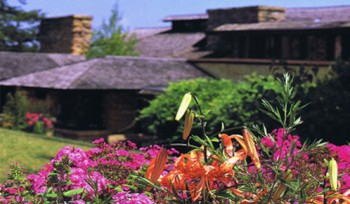 Frank Lloyd Wright’s houses are revered as twentieth century architectural masterpieces but his work as a landscape designer is lesser known. Wright considered the house and its surrounding landscape design one organic whole and as a master landscape designer set out to place his buildings in settings as impressive and beautiful as the houses they surrounded.
Frank Lloyd Wright’s houses are revered as twentieth century architectural masterpieces but his work as a landscape designer is lesser known. Wright considered the house and its surrounding landscape design one organic whole and as a master landscape designer set out to place his buildings in settings as impressive and beautiful as the houses they surrounded.
‘Wright was confident and unafraid to obscure his architectural designs with trees or to create bold splashes of colour with plants. He created layers of beauty that resulted in a seamless connection between inside and outside.’ (Fell)
In his book, The Gardens of Frank Lloyd Wright, Derek Fell has collected from Lloyd’s autobiography, lectures, magazine articles and comments to staff and students, ten landscape tips that exemplify Wright’s approach to landscape design.
• Expose the house foundation to show where it meets the ground. To soften hard architectural lines he preferred to plant trailing vines in dish planters on pedestals and window box planters. The draping effect helped the building blend with nature.
• Where an exposed site needs plantings for shelter or aesthetic appeal, first consider the use of indigenous plants as these are likely to be more reliable and require less maintenance than non-indigenous plants.
• Flower colour among plants is secondary to texture, shape and form. However, Wright did like to have flowering trees and shrubs for fleeting colour, and also perennials as they come back every year and provide flowers for cutting to create indoor floral arrangements.
• Try to make your home landscape distinctive. Wright saw the use of desert natives as vital in making his winter home part of the desert and to create interesting sculptural accents.
• Allow trees and shrubs to grow naturally. Trees and shrubs that outgrow their boundaries can be carefully sized back and still look natural. Do not trim shrubs into topiary shapes so severely that they look like meatballs.
• Take as much interest in the house surroundings as you do the house interior. Plant for privacy and shelter as well as aesthetic appeal.
• Create vistas where none exist and preserve vistas that have become obscured by vegetation. A view of water – a lake or river is especially desirable.
• Consider a vine-covered pergola leading from the house to a garden room or between two sunny garden spaces. This produces a leafy tunnel and a sense of compression, then release, when you emerge into the sunlight.
• Use sculpture as focal points, particularly at the end of a path or entrance to a garden space. But choose sculpture in scale with its surroundings.
• Digest other garden styles such as French formality, Italian baroque and Japanese imperial, but do not slavishly copy them.
Frank Lloyd Wright gardened on a large scale, altering the natural landscape to create magnificent vistas that disappear into infinity. Wright created lakes, bridges, woodland, hills and contours where none previously existed. Because Wright was an architect as well as a landscape designer he not only knew how best to site a residence in a particular location and how best to improve a challenging landscape, but also where to leave nature alone, as he did at Fallingwater in Pennsylvania’s rural Laurel Highlands.
















